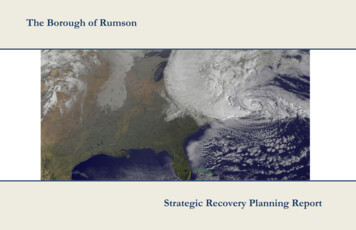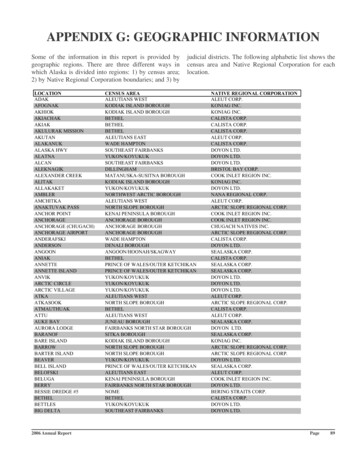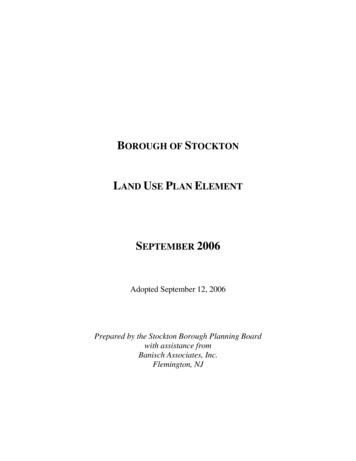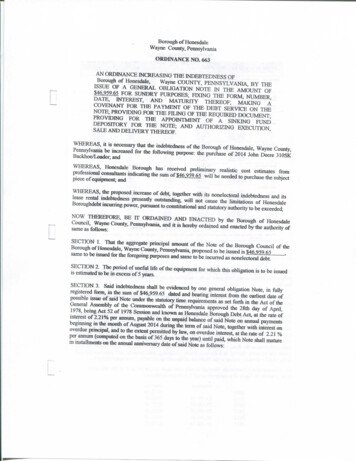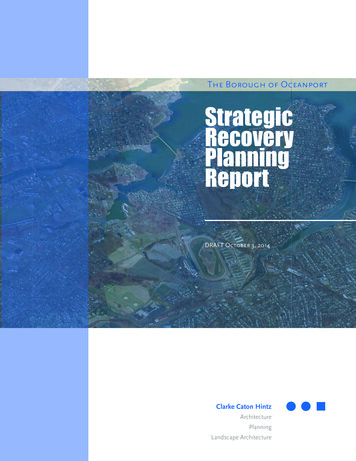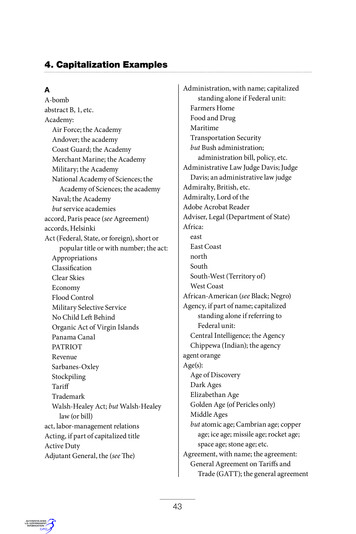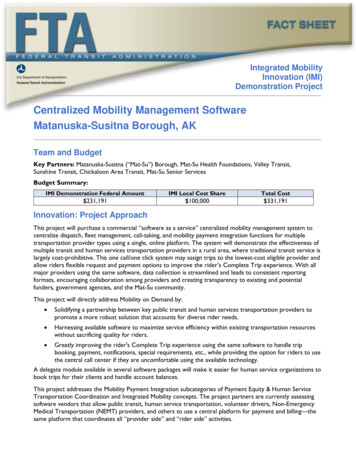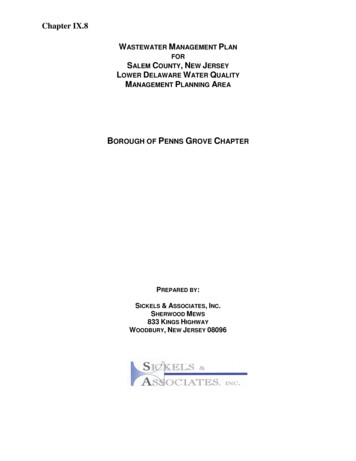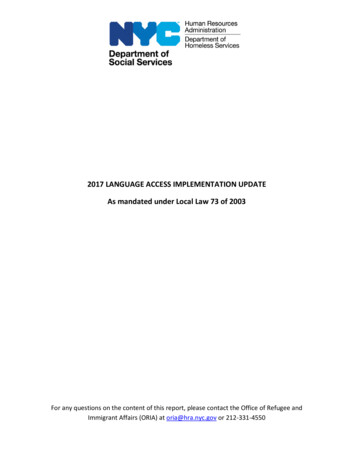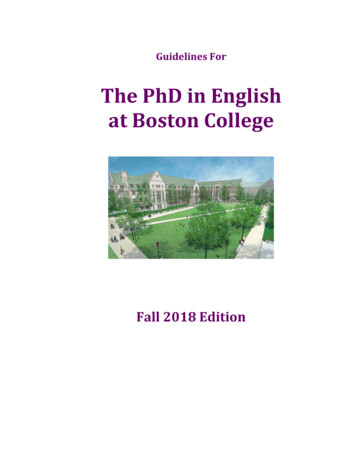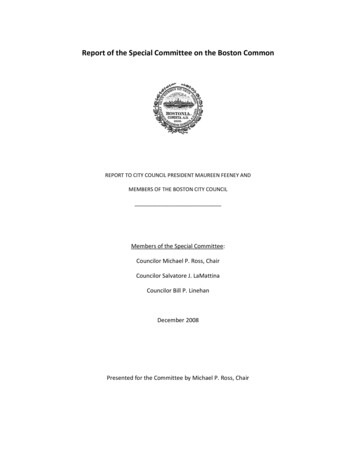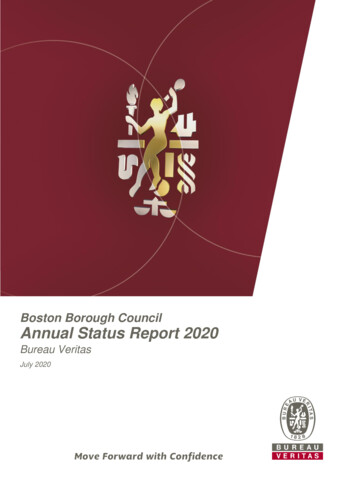
Transcription
Boston Borough CouncilAnnual Status Report 2020Bureau VeritasJuly 2020
Document Control SheetIdentificationClientDocument TitleBureau Veritas RefNo.Boston Borough Council2020 Annual Status ReportCompany NameContact NamePositionBureau Veritas UK LimitedHannah SmithSenior Consultant5th Floor66 Prescot StreetLondonE1 8HGAIR8419927Contact 0/07/2020J DaviesJ DaviesBoston Borough CouncilNick DavisEnvironmental Health OfficerMunicipal BuildingsWest StreetBostonPE21 8QRConfigurationReason for Issue/Summary ofChangesUpdate following Council’s commentsNameJob TitlePrepared ByJ DaviesConsultantApproved ByH SmithSenior ConsultantStatusDraftFinalSignatureCommercial In Confidence Bureau Veritas UK LimitedThe copyright in this work is vested in Bureau Veritas UK Limited, and the information contained herein is confidential. Thiswork, either in whole or in part, may not be reproduced or disclosed to others or used for any purpose, other than for internalclient evaluation, without Bureau Veritas’ prior written approval.Bureau Veritas UK Limited, Registered in England & Wales, Company Number: 01758622Registered Office: Suite 206 Fort Dunlop, Fort Parkway, Birmingham B24 9FDDisclaimerThis Report was completed by Bureau Veritas on the basis of a defined programme of work and terms and conditions agreedwith the Client. Bureau Veritas confirms that in preparing this Report it has exercised all reasonable skill and care taking intoaccount the project objectives, the agreed scope of works, prevailing site conditions and the degree of manpower and resourcesallocated to the project.Bureau Veritas accepts no responsibility to any parties whatsoever, following the issue of the Report, for any matters arisingoutside the agreed scope of the works.This Report is issued in confidence to the Client and Bureau Veritas has no responsibility to any third parties to whom thisReport may be circulated, in part or in full, and any such parties rely on the contents of the report solely at their own risk.Unless specifically assigned or transferred within the terms of the agreement, the consultant asserts and retains all Copyright,and other Intellectual Property Rights, in and over the Report and its contents.Any questions or matters arising from this Report should be addressed in the first instance to the Project Manager.
Boston Borough Council2020 Air Quality Annual Status Report(ASR)In fulfilment of Part IV of theEnvironment Act 1995Local Air Quality ManagementJuly 2020LAQM Annual Status Report 2020
Boston Borough CouncilLocal AuthorityOfficerNick DavisDepartmentEnvironmental and HealthAddressMunicipal Buildings, West Street, Boston,PE21 8QRTelephone01205 314200E-mailNick.Davis@boston.gov.ukReport ReferencenumberAIR8419927 ASR2020DateJuly 2020LAQM Annual Status Report 2020
Boston Borough CouncilExecutive Summary: Air Quality in Our AreaAir Quality in Boston Borough CouncilAir pollution is associated with a number of adverse health impacts. It is recognisedas a contributing factor in the onset of heart disease and cancer. Additionally, airpollution particularly affects the most vulnerable in society: children and older people,and those with heart and lung conditions. There is also often a strong correlation withequalities issues, because areas with poor air quality are also often the less affluentareas1,2.The annual health cost to society of the impacts of particulate matter alone in the UKis estimated to be around 16 billion3.Boston’s air quality issues derive primarily from the usage of private vehicles for shortfrequent journeys within Boston. For example, as detailed in the Boston TransportStrategy (2016-2036), nearly half of travel to work journeys start and end within Boston,and half of these journeys are made by private motor vehicles predominantly alongmajor arterial roads (Sleaford Road, John Adams Way, Spalding Road and SplisbyRoad), causing peak period congestion. Currently Boston Borough Council (‘theCouncil’) has two designated Air Quality Management Areas (AQMAs), these arelocated at Haven Bridge and Bargate Bridge. Both AQMAs have been declared inrelation to exceedances of the AQS annual mean objective of 40µg/m3 for NO2, largelydue to traffic emissions from traffic along Sleaford Road, John Adams Way, SpaldingRoad and Splisby Road, which connect to form the main transportation network withinthe Borough.The two AQMAs can be seen online at la id 27, details of the AQMAs are provided in Table 2.1 and boundarymaps are presented in Appendix D: Maps of Monitoring Locations and AQMAsAn update to the previous 2010 AQAP was drafted by the Council during 2019/2020and approved by Defra in June 2020. The draft AQAP can be found on the Council’swebsite6 and a final draft will be published following the Council’s addition of targetedmeasures in response to 2020 AQAP appraisal comments. The AQAP measures focus1Environmental equity, air quality, socioeconomic status and respiratory health, 2010Air quality and social deprivation in the UK: an environmental inequalities analysis, 20063 Defra. Abatement cost guidance for valuing changes in air quality, May 20132LAQM Annual Status Report 2020i
Boston Borough Councilon improving air quality within both the existing AQMAs and across the Borough. The2018 Detailed Modelling Assessment informed the development of the updated AQAPvia dispersion modelling, identifying areas of concern and where the Council mustfocus air quality improvements and monitoring regimes. The Council’s establishedsteering group, consisting of internal lead officers across a number of relevantdepartments and representatives from Lincolnshire County Council. Regular meetingswill remain in place in order to develop and continually engage across local authoritiessurrounding air quality issues.During 2019, the Council monitored NO2 at 16 sites via a network of roadside locateddiffusion tubes. The 2018 diffusion tube monitoring sites DT6, DT7, DT10 and DT15were removed and four new sites were installed for the 2019 reporting period at SouthEnd and along the London Road approach to the A16 (sites DT16, DT17, DT18, &DT19). DT18 and DT19 were placed by Spalding roundabout and DT16 and DT17were placed in South End on the approach to the junction with Haven Bridge. DT16,DT17, DT18 & DT19 are situated outside of the declared AQMAs, at locations identifiedwithin the 2018 modelling assessment to be in exceedance of the AQS annual meanNO2 40µg/m3 objective. In addition, a new diffusion tube site (DT22) was installed fromMarch 2019 onwards at a location 8 meters from the edge of the Liquorpondroundabout within the Haven Bridge AQMA. DT22 replaced DT2 and was installed100m west of the original location, in response to the new location indicating one ofthe highest modelled exceedances within the 2018 modelling assessment in additionto being within close proximity to a higher number of relevant receptors than the DT2location, within the Haven Bridge AQMA.During 2019, 3 sites (DT1, DT3, DT20) recorded NO2 annual mean concentrations inexcess of 40µg/m3, and 2 sites (DT4, DT8) reported concentrations to be within 10%of the AQS objective (above 36µg/m3). Following the fall-off with distance correctioncalculation4 (where relevant), 2 monitoring sites (DT1, DT3) continued to exceed theAQS NO2 annual mean objective and DT4 continued to report an annual meanconcentration within 10% of the AQS objective. All monitoring locations that monitoredexceedances or were found to be close to exceedance, before distance correction wasapplied, are located within the Haven Bridge ata/no2-falloff.htmlLAQM Annual Status Report 2020ii
Boston Borough CouncilFor the monitoring locations that have not undergone relocation during 2018/19, thereis a largely downward trend observed at 7 sites (DT3, DT8, DT9, DT12, DT14, DT20& DT21) with an increase in comparison to 2018 concentrations at 3 sites (DT1, DT4& DT5). DT1 reported the highest increase of 6.8µg/m3 in 2019 NO2 annual meanconcentration, when compared to 2018, and evidently reported the highestconcentration within Boston in 2019 (49.2µg/m3). DT1 is located at the edge of theLiquorpond roundabout, 1.5m from the kerb, and is subject to high volumes of queuingtraffic. No monitoring sites outside of the declared AQMA boundaries reportedconcentrations to exceed 36µg/m3 – with DT18 reporting the highest concentration(33.8µg/m3). Annual mean NO2 concentrations recorded outside of the declaredAQMAs in Boston remain well below the AQS objective limit.In accordance with Defra LAQM.TG(16)5 the 2019 results indicate that an exceedanceof the 1-hour mean objective is unlikely to have occurred at any site within 2019 as noconcentrations reported 60µg/m3 or above.Following a review of the 2019 monitoring data, the Council intend to maintain thecurrent boundary of the Haven Bridge AQMA. The Council will however considerrevocation of the Bargate AQMA in response to recent years’ monitoring data trends.This will be put before the Council’s Cabinet later this year.Actions to Improve Air QualityThe AQAP for Boston Borough Council is the key document in support ofimprovements to air quality within the Borough. The measures set out within the 2020updated AQAP have been developed to achieve compliance with the NO2 annual meanAQS objective. In order to continually review and progress the measures, the Councilmeet regularly with lead officers and representatives from Lincolnshire County Councilat both an officer and political level. The draft AQAP (approved June 2020) will befurther updated before publishing as a final draft, in line with Defra’s appraisalcomments surrounding targeted measures in relation to the Boston Bypassdevelopment (measure 1).In recognition of the importance that transport plays, the Council, in partnership withLincolnshire County Council, has released a Boston Transport Strategy (2016-2036)that builds upon the improvements delivered since the last Strategy was published ebruary-18-v1.pdfLAQM Annual Status Report 2020iii
Boston Borough Council2006 - ‘The Transport Strategy for Boston 2006 – 2021 and beyond’. The strategyfocuses on a sustainable transport network which supports the growth of Boston andhelps to improve air quality. A key objective of this new strategy is to deliver elementsof the Boston Bypass, which in the long term will provide a western link road betweenthe A16 in the south of the town and the A16 in the north. The new road links intend toserve new developments to the west of Boston, easing reliance on inner city arterialroads for journeys made beyond Boston. In parallel, objectives concentrate onproviding alternative forms of transport, EV infrastructure, investing in walking, cyclingand public transport infrastructure to promote a modal shift away from private vehiclesfor short journeys made within Boston.Overall, the strategy includes a high level of consideration in relation to thereconfiguration of roads, sustainable transport plans and modes of transport,alternative modes of transport to private vehicles and to overall reduce the impact ofthe transport system on air quality within the local area.In addition, a number of actions have been completed within the Borough during 2019designed at improving local air quality: Installation of a number of publicly accessible electric vehicle chargingpoints in Boston, including at 5 car parks across the Borough and theGeoff Moulder leisure centre, and; Continued promotion of cycling as a travel alternative with a proposalmade to improve the Council’s current cycling infrastructure; The requirement to provide EV charging on many commercial andhousing development through planning.Conclusions and PrioritiesDuring 2019, the Council successfully developed their updated AQAP and the draftwas subsequently accepted by Defra in June 2020, awaiting final publication by theCouncil. The Council plan to continue to develop the new AQAP, based on commentsderiving from the appraisal document, where additional targeted measures will besought to help support air quality improvements during the progression of the BostonBypass development (Measure 1).LAQM Annual Status Report 2020iv
Boston Borough CouncilDuring 2019, before distance correction was applied, 3 monitoring locations recordedNO2 annual mean concentrations to be above the NO2 annual mean AQS objective of40µg/m3, and 2 monitoring locations reported concentrations to be within 10% of theannual mean objective. All monitoring sites either in exceedance or within 10% of theannual mean objective are located within the Haven Bridge AQMA. Following theapplication of the fall-off with distance correction, 2 monitoring locations remainedwithin exceedance (DT1 – 49.2µg/m3 & DT3 – 46.5µg/m3) and 1 site (DT4 – 39.8µg/m3)remained within 10% of the AQS objective.In comparison to 2018, there is a continued downward trend observed in 2019 for 7diffusion tubes; 3 are located within the Bargate Bridge AQMA, 2 are within the HavenBridge AQMA and 2 are located outside of the AQMAs. There is a slight increase incomparison to 2018 concentrations at 3 locations, all within the Haven Bridge AQMA.The greatest increase in comparison to 2018 monitoring data was reported at DT1(8µg/m3). DT1 reported the highest NO2 annual mean concentration within Boston in2019 (49.2g/m3) and is located at the edge of the Liquorpond roundabout (within theHaven Bridge AQMA). Annual mean NO2 concentrations recorded outside of thedeclared AQMAs in Boston remain well below the AQS objective limit, with DT18reporting the highest concentration outside of an AQMA in 2019 (33.8µg/m3).In accordance with Defra LAQM.TG(16)5, the results indicate that an exceedance ofthe 1-hour mean objective is unlikely to have occurred at any site within 2019 as noconcentrations were reported at 60µg/m3 or above.Due to the continued exceedances recorded within the AQMA, together with the resultsof the 2018 modelled data, the Haven Bridge AQMA is to remain in place. Followingthe application of distance correction, there are no 2019 exceedances orconcentrations within 10% of the AQS objective within the Bargate Bridge AQMA, withthe last exceedance within the AQMA reported in 2017 – DT9 (43.6µg/m3), which thenreported 38.7µg/m3 following distance correction. The Council therefore propose toconsider revocation of the Bargate AQMA.Boston Borough Council intend to concentrate efforts on the development of the 2020AQAP measures and continued actions in relation to the Haven Bridge AQMA toachieve a continuous reduction in NO2 concentrations.LAQM Annual Status Report 2020v
Boston Borough CouncilLocal Engagement and How to get InvolvedAs the main source of air pollution within Boston Borough Council arises from transportsources, a way for the local community to help improve air quality in the area would beto seek alternatives to the way they usually travel. In July 2019 the Council organiseda free cycling roadshow, aimed at promoting cycling within the area including a freecycle clinic offering maintenance and repairs for local residents.The following are suggested alternatives to private travel that are given within theupdated AQAP measures that would contribute to improving the air quality within theBorough: Encouragement of electric vehicle use – An increase of electric charging pointsacross the Borough; Use of public transport – facility improvements and investigate the feasibility ofthe provision of lower emission buses, which will help reduce pollutantconcentrations through the reduction in the number of private vehicles andcongestion; Walk or cycle if your journey allows – Improvements to cycling infrastructureand promotion of alternative travel across the Borough. From choosing to walkor cycle, the number of vehicles is reduced and also there is the added benefitof keeping fit and healthy; Car/lift sharing schemes– Where a number of individuals are making similarjourneys, such as travelling to work or to school, car sharing reduces the numberof vehicles on the road and therefore the amount of emissions being released.LAQM Annual Status Report 2020vi
Boston Borough CouncilTable of ContentsExecutive Summary: Air Quality in Our Area . iAir Quality in Boston Borough Council . iActions to Improve Air Quality . iiiConclusions and Priorities . ivLocal Engagement and How to get Involved . vi1Local Air Quality Management . 12Actions to Improve Air Quality. 22.1Air Quality Management Areas . 22.2Progress and Impact of Measures to address Air Quality in Boston BoroughCouncil . 52.3PM2.5 – Local Authority Approach to Reducing Emissions and/orConcentrations.123Air Quality Monitoring Data and Comparison with Air QualityObjectives and National Compliance . 133.1Summary of Monitoring Undertaken .133.1.1Automatic Monitoring Sites . 133.1.2Non-Automatic Monitoring Sites. 133.2Individual Pollutants .133.2.1Nitrogen Dioxide (NO2). 14Appendix A: Monitoring Results . 16Appendix B: Full Monthly Diffusion Tube Results for 2019 . 23Appendix C: Supporting Technical Information / Air Quality MonitoringData QA/QC . 25Appendix D: Maps of Monitoring Locations and AQMAs . 28Appendix E: Summary of Air Quality Objectives in England . 32Glossary of Terms . 33References . 34List of TablesTable 2.1 – Declared Air Quality Management Areas .4Table 2.2 – Progress on Measures to Improve Air Quality .8Table A.1 – Details of Non-Automatic Monitoring Sites . 16Table A.2 – Annual Mean NO2 Monitoring Results . 18Table B.1 - NO2 Monthly Diffusion Tube Results - 2019 . 23LAQM Annual Status Report 2020vii
Boston Borough CouncilTable C.1 – National Bias Adjustment Factors 2015 - 2019 . 25Table E.1 – Air Quality Objectives in England . 32List of FiguresFigure A.1– Trends in Annual Mean NO2 Concentrations – Haven Bridge AQMA . 20Figure A.2- Trends in Annual Mean NO2 Concentrations Bargate Bridge AQMA . 21Figure A.3 - Trends in Annual Mean NO2 Concentrations outside of the AQMAs . 22Figure C.1 – National Bias Adjustment Factor 2019 for Boston Borough Council . 25Figure C.2 - Fall off Distance Correction Calculations for Sites 9, 14 & 20 . 27Figure D.1 - Diffusion Tube Locations - Haven Bridge AQMA . 28Figure D.2 – Diffusion Tube Locations – Bargate Bridge AQMA . 29Figure D 3 - Diffusion Tube Locations – Boston South . 30Figure D.4 – Diffusion Tube Monitored Concentrations within Boston BoroughCouncil. 31LAQM Annual Status Report 2020viii
Boston Borough Council1Local Air Quality ManagementThis report provides an overview of air quality in Boston Borough Council during 2019.It fulfils the requirements of Local Air Quality Management (LAQM) as set out in PartIV of the Environment Act (1995) and the relevant Policy and Technical Guidancedocuments.The LAQM process places an obligation on all local authorities to regularly review andassess air quality in their areas, and to determine whether or not the air qualityobjectives are likely to be achieved. Where an exceedance is considered likely thelocal authority must declare an Air Quality Management Area (AQMA) and prepare anAir Quality Action Plan (AQAP) setting out the measures it intends to put in place inpursuit of the objectives. This Annual Status Report (ASR) is an annual requirementshowing the strategies employed by Boston Borough Council to improve air quality andany progress that has been made.The statutory air quality objectives applicable to LAQM in England can be found inAppendix E.LAQM Annual Status Report 20201
Boston Borough Council2Actions to Improve Air Quality2.1 Air Quality Management AreasAir Quality Management Areas (AQMAs) are declared when there is an exceedanceor likely exceedance of an air quality objective. After declaration, the authority mustprepare an Air Quality Action Plan (AQAP) within 12-18 months setting out measuresit intends to put in place in pursuit of compliance with the objectives.A summary of the two AQMAs, Haven Bridge and Bargate Bridge AQMAs, declaredby Boston Borough Council can be found in Table 2.1. Further information related todeclared or revoked AQMAs, including maps of AQMA boundaries are available onlineat ?la id 27 see full list at https://ukair.defra.gov.uk/aqma/list. Alternatively, see Appendix D: Maps of MonitoringLocations and AQMAs, which provides for a map of air quality monitoring locations inrelation to the AQMAs.In 2019, the Council continued to work on the draft update to the existing AQAP, whichwas previously updated in 2010. The AQAP focused on the Haven Bridge (declared2001) and Bargate Bridge (declared 2005) AQMAs. The draft plan was accepted byDefra in June 20206 however Defra has encouraged the Council to develop furthertargeted measures in relation to the proposed long term outer distributor roadimprovements and LGVs in order to fall more in line with AQAP timescales. TheCouncil will therefore review the approved draft AQAP in response to Defra’s appraisalcomments before publishing a final document.As a result of the 2020 Covid-19 global pandemic, the proposed measuresdocumented within the AQAP Draft, have been updated within Table 2.2 as far as isreasonably practicable. The Council will therefore include both updated measures inresponse to the 2020 AQAP appraisal recommendations alongside a more detailedprogress update within next year’s ASR.In support of the AQAP update, as discussed within last year’s ASR, a DetailedModelling Assessment was completed to help develop and focus the draft AQAPmeasures. The three discrete areas of modelled exceedance relative to the NO2 annualmean AQS objective limit are as oads/2020/02/Boston-Borough-Council-AQAP Draft v2.0.pdfLAQM Annual Status Report 20202
Boston Borough Council A Continuous stretch spanning Sleaford Road, Liquorpond Street, John AdamsWay and South End covering parts of Haven Bridge AQMA; Spilsby Road approach to Wide Bargate covering Bargate Bridge AQMA; and A continuous stretch of the A16 – Spalding Road spanning north and south ofthe South Forty Foot Drain.The conclusions from the modelling assessment recommended to declare either oneAQMA within Boston, combining all areas of identified exceedance (and the two currentAQMAs), covering the main arterial highway network within Boston or to declare threediscrete AQMAs covering the three located areas of exceedance individually. TheCouncil proposed additional monitoring at the modelled exceedance locations to helpinform any amendment to the existing AQMA boundaries.In preparation of the 2019 reporting period and in response to the modelledexceedance locations, the 2018 diffusion tube monitoring DT6, DT7, DT10 and DT15were relocated to sites located along the London Road approach to the A16 (relocatedsites DT16, DT17, DT18, & DT19). DT18 and DT19 were placed by Spaldingroundabout and diffusion tube sites 16 and 17 were placed along the A1138. DT16 andDT17 are two areas outside of a declared AQMA boundary, identified within the 2018modelling assessment to be in exceedance of the AQS annual mean NO2 objectivelimit. In addition, diffusion tube site 22 replaced DT2 from March 2019 and wasrelocated 100m west of the original location to a site 8 meters from the edge of theLiquorpond roundabout in response to the location indicating one of the highestmodelled exceedances within the 2018 modelling assessment, close to a number ofrelevant receptors, within the Haven Bridge AQMA.Following the 2019 diffusion tube results, the Council propose to keep the HavenBridge AQMA in place due to the continued exceedances and aim to review thedesignation of the Bargate Bridge AQMA, which has not reported an exceedance at amonitoring location since 2017. Following monitoring no exceedances were reportedbeyond the current AQMA boundaries.LAQM Annual Status Report 20203
Boston Borough CouncilTable 2.1 – Declared Air Quality Management AreasAQMANameDate ofDeclarationPollutantsand AirQualityObjectivesCity /TownOne LineDescriptionIs airquality inthe AQMAinfluencedby roadscontrolledbyHighwaysEngland?Level of Exceedance(maximummonitored/modelledconcentration at alocation of relevantexposure)AtDeclarationA majorhighwayconsisting ofJohn AdamsWay (A16),Queen Streetand LiquorpondStreet (A52)NowAction PlanNameDate ofPublicationBostonBoroughCouncil,AQMA 1NO2 AnnualAir- anQualityBridgeActionPlan(draft)BostonBoroughAQMA 2Council,Key roundaboutNO2 AnnualNoAir01/03/2005Bostonfor the A16 7BridgeActionPlan(draft)*Draft AQAP available on Council’s website. Draft approved June 2020; to be updated in line with AQAP appraisal comments ahead of final draft t/uploads/2020/02/Boston-Borough-CouncilAQAP Draft ds/2020/02/Boston-Borough-CouncilAQAP Draft v2.0.pdf Boston Borough Council confirm the information on UK-Air regarding their AQMA(s) is up to dateLAQM Annual Status Report 20204
Boston Borough Council2.2 Progress and Impact of Measures to address AirQuality in Boston Borough CouncilDefra’s appraisal of last year’s ASR confirmed that the Council should include theproposed update to the AQAP together with a discussion of the 2020 measures withinthis year’s ASR. The appraisal further requested that mitigation measures for PM 2.5should be considered within the 2020 ASR, and the AQMA reference for Haven Bridgewithin the Report Submission Website (RSW) is consistent with the 2020 ASR. TheCouncil has actioned each of the appraisal comments, with the current 2020 AQAPmeasures updated as far as is reasonably practicable in Table 2.2, in light ofrestrictions related to the ongoing 2020 Covid-19 pandemic.Boston Borough Council have taken forward a number of direct measures during thecurrent reporting year of 2019, in pursuit of improving local air quality. Details of allmeasures completed, in progress or planned are set out in Table 2.2.More detail on these measures can be found in the Council’s Local Air QualityManagement – Air Quality Action Plan (Joint AQAP draft update 2020), the BostonTransport Strategy (2016-2036) and Local Plan. In March 2019, the new Local Plandeveloped in collaboration with South Holland District Council and LCC was adopted.Key measures which have been progressed in line with the 2020 AQAP draft updateinclude: Installation of a number of publicly accessible electric vehicle charging points inBoston, including at 5 car parks across the Borough and the Geoff Moulderleisure centre, and; Promotion of cycling as a travel alternative, with a proposal made to improvecycling infrastructure, the July 2019 free cycling roadshow and the progressionof initiatives such as free cycle training and preparation of cycle promotionsacross local schools (Bikeability). Provision of EV charging at new housing and commercial developments acrossthe district.Boston Borough Council expects the following measures to be completed over thecourse of the next reporting year:LAQM Annual Status Report 20205
Boston Borough Council Release of a final draft of the 2020 approved AQAP draft, to include additionaland updated measures in line with the 2020 appraisal comments; Seek funding opportunities for a feasibility study for further phases of the BostonDistributor road; Investigate emission standard
Boston Borough Council LAQM Annual Status Report 2020 Local Authority Officer Nick Davis Department Environmental and Health Address Municipal Buildings, West Street, Boston, PE21 8QR Telephone 01205 314200 E-mail Nick.Davis@boston.gov.uk Report Reference number AIR8419927_ASR2020 Date July 2020
